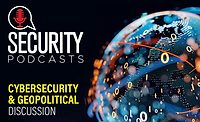The Money Laundering Machine: Inside the global crime epidemic - Episode 24
Check out episode 24 of The Cybersecurity & Geopolitical Discussion.
Get caught dealing drugs, and they practically throw away the key! Fall foul of the law by money laundering millions of dollars, however, and you’ll likely be back laundering more cash in around six years.
This is just one of the many paradoxes surrounding one of the world’s most widespread criminal activities and is one of the reasons it’s so popular, particularly among well-establish organized criminal gangs. In this episode, our regular panel of Cyjax CISO Ian Thornton-Trump, Red Goat Security’s Lisa Forte and Grey Hare Media’s Philip Ingram MBE dive deep into this dirty world.

The Money Laundering Machine: Inside the global crime epidemic - Episode 24
Our trio of hosts discuss paradoxes surrounding money laundering and the reasons it’s so popular, particularly among well-establish organized criminal gangs.
Listen to more Security podcasts.
Three for the money
Lisa kicks off the debate, explaining the three key stages of money laundering, all of which must be painstakingly executed to liberate, distribute and hide the most funds successfully. The focus then shifts to what’s involved in launching a scam and the methods deployed to move money, viewed through the lens of some of the more high-profile cases, such as the Pandora Papers.
The complexity of money laundering activities and their huge reach and influence is then examined. The need for profitable businesses to act as fronts has actually benefited many of the communities targeted by criminal gangs, in whose interest it is, ironically, to crack down on neighbourhood crime so that the local shops they are extorting can flourish. This makes for safer, more stable environments and more profitable local businesses, which is how communities can gain by being exploited.
Spreading corruption
Having sourced the funds, successfully distributing, concealing and ultimately legitimizing the dirty money almost always means securing friends in high places, spreading corruption to the highest echelons of society. And our panel are quick to point out that this is why the influence of money laundering capers is so widespread.
Their attention next turns to traceability, which is key to law enforcement agencies cracking the money laundering code and disrupting the multi-layered scams. Ian points out how the Covid pandemic acted as a catalyst, making it easier to launder money as cashless payments exploded and cryptocurrency boomed. In contrast, blockchain’s immutability has become a key weapon in identifying and tracking the money trails and catching the scammers.
The exploited ecosystem
Of course, most crimes result in unfortunate innocent victims. In money laundering our panel conclude that there is a disturbing exploited ecosystem of unsuspecting or forced individuals who act as the distribution network of funds or valuable items. These people not only suffer at the hands of the gangs, but also frequently end up in jail while their abusers remain at large.
Our journey ends with our panel discussing what the future holds. Will innovation like AI help or hinder law enforcement? Will money laundering ever be stamped out? Tune in to discover the conclusions our experts draw, and to gain a fascinating insight into this ongoing crime wave.
Until next time…
Looking for a reprint of this article?
From high-res PDFs to custom plaques, order your copy today!



.jpg?height=200&t=1643748762&width=200)


